Space that opens to one side
・・・・・・・・・・
Hello everyone, how are you? This is Tanaka from GRIDFRAME.
This time, I would like to introduce the renovated SOTOCHIKU showroom. This showroom is also our office. I am writing this article in the showroom right now.
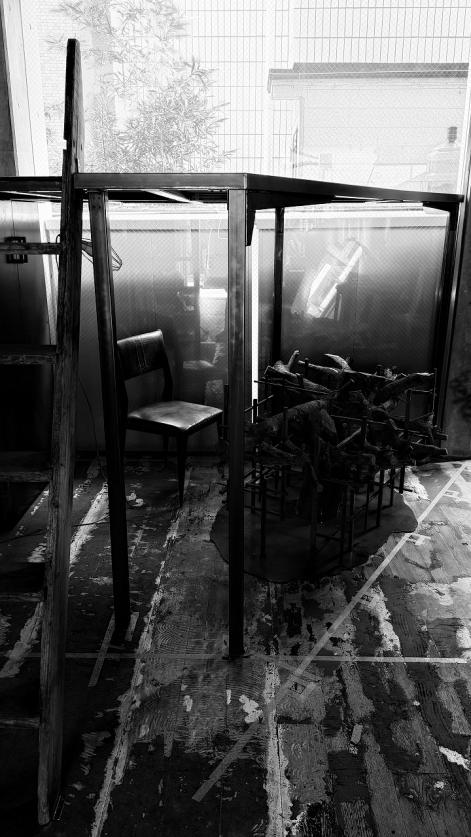
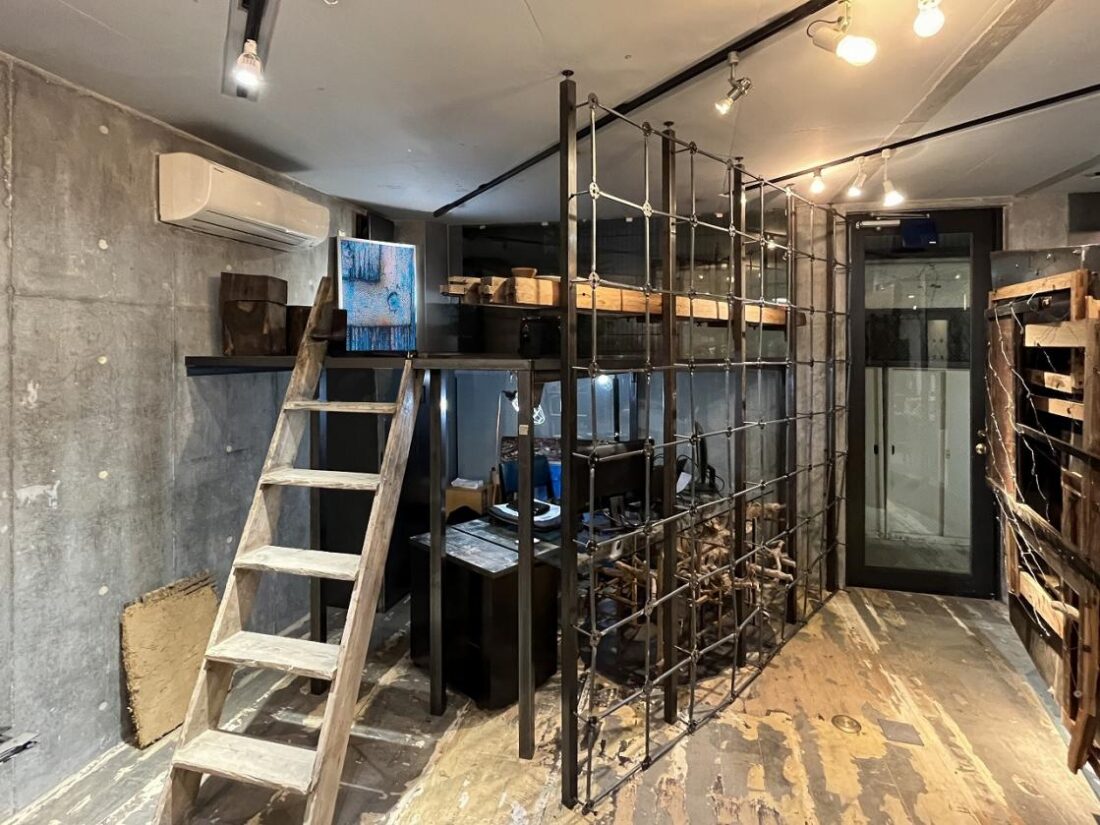
<Ideal office>
In my attempt to create the ideal office for creative work, I decided to create a loft in part of the room, dividing it into two sections, 1m above and 1.5m below, even though the ceiling was only a normal height of about 2.5m.
I can trace this reason back to something I wrote a long time ago when I was a student in Buffalo, New York.
…..
【Not a bird, but like a squirrel】
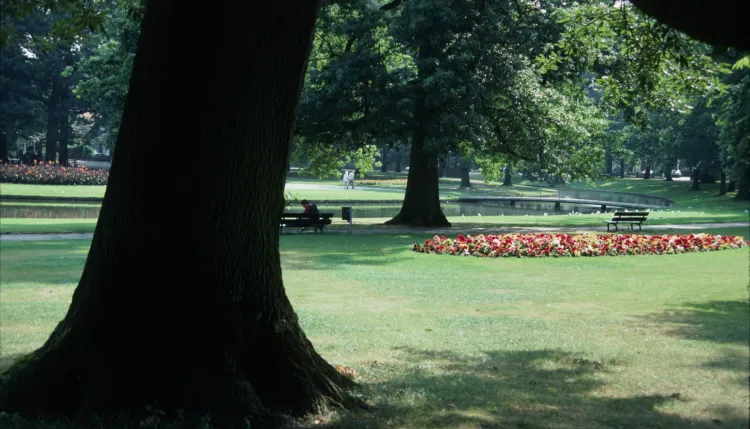
There are many chestnut trees outside the school building, and many squirrels that live on them.
There was tall grass at my feet, about the same height as the squirrels, and in the autumn I enjoyed watching them search for chestnuts.
He ran here and there, but it wasn’t there, he ran there and it wasn’t there either. Then he came across some chestnuts and the squirrel seemed happy too.
If it were a bird, I could look down from the sky and find it right away.
Everyone dreams of being able to see things from a bird’s-eye view. I’m no exception.
But I want to live like a squirrel.
The squirrel pushes aside the grass and touches it. It touches the soil. It bumps into stones. It bumps into insects. If it can’t reach the chestnuts no matter what it does, it can climb a tree and look down. By climbing a tree, it can learn a lot about the tree.
A lifetime of many encounters. A lifetime of many opportunities to come into contact.
In that sense, squirrels would outdo birds.
I want to live like a squirrel.
After all, hundreds of millions of years of evolution have not given us humans wings.
・・・・・・・・・・
[Space that opens to one side]
But when I think back, my childhood dream was always to become an airline pilot. So I think I wanted to be a bird then. But then I started lying down and reading manga too much lol, and my eyesight got worse in my second year of high school, and all that remained was my longing for the sky.
And my longing for the sky influenced my life thereafter.
“Life would be boring if the sky was closed, and there would be no need to live if we could know the future.”
Since I decided to become an architect in my late 20s, I have come to see the sky as a space that is open equally to all living things on Earth. Being open in space reminds me that the future is also open equally to all living things on Earth.
In other words, our lives are open in one direction.
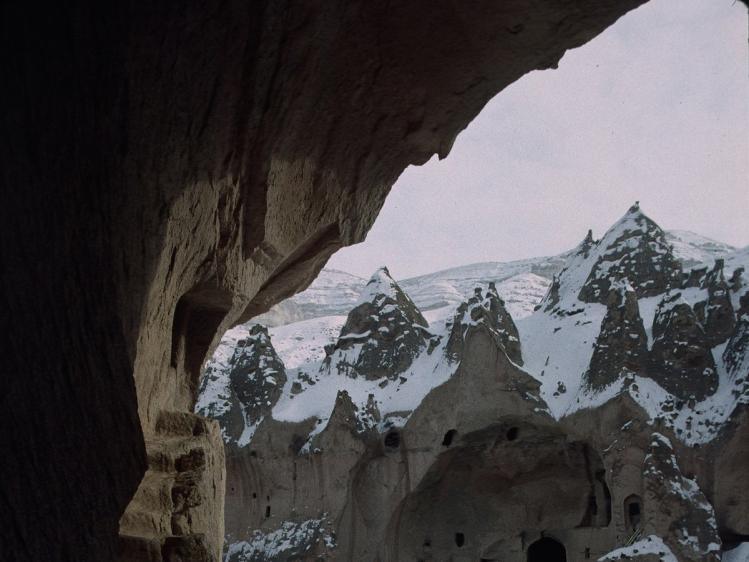
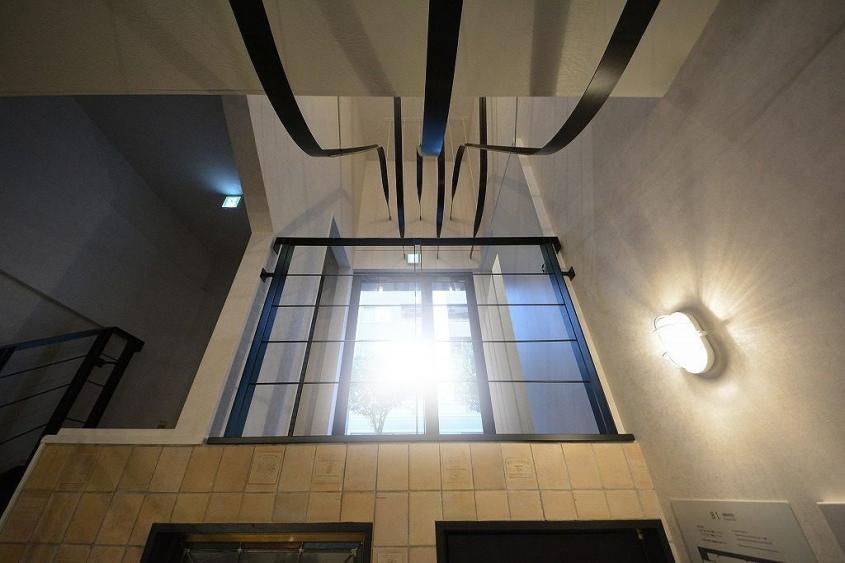
So when I create spaces, I have always tried to create “spaces that open to one side,” to provide a space where people can “be their open self” mentally.
In the nearly 27 years we’ve been working in the space creation business, there was a time when we, who pride ourselves on creating spaces creatively, faced difficulties.
For example, from around 2010, images of popular stores on social media began to flood the internet, and the number of people wanting to imitate their favorite stores increased dramatically. While other countries, which should be in the same environment, were seeing an increasing number of never-before-seen store spaces, Japan alone was becoming conservative and its creative momentum was fading. This is the situation we refer to as being mentally closed off to the future.
Perhaps this is also reflected in the fact that an increasing number of people are unable to realize that they are irreplaceable beings and are suffering from mental illness.
It seems to me that Japan’s creativity has been frozen for a long time, while other countries, especially Asian countries such as China, have been producing a lot of creative things and spaces.
“Space that opens to one side” can be an antithesis to the current trend in Japan. The space we want to create is one where people can continue to try their best, believing that they can make the future better, and questioning the true value of their ideas to society through trial and error.
Not like a bird, but like a squirrel.
As times are about to change dramatically, I believe it is necessary to think about and present what kind of space people can choose the information they receive, maintain a state of isolation, and be creative.
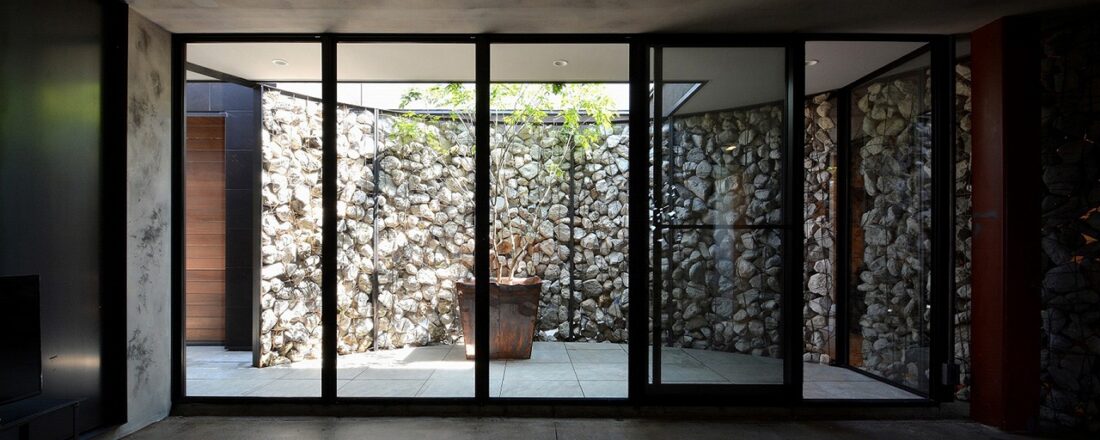
[Space under the loft: trial and error like a squirrel]
Based on the concept described above, we have now created an office space within the showroom.
The space under the loft is where I pursue creative work such as designing and writing.
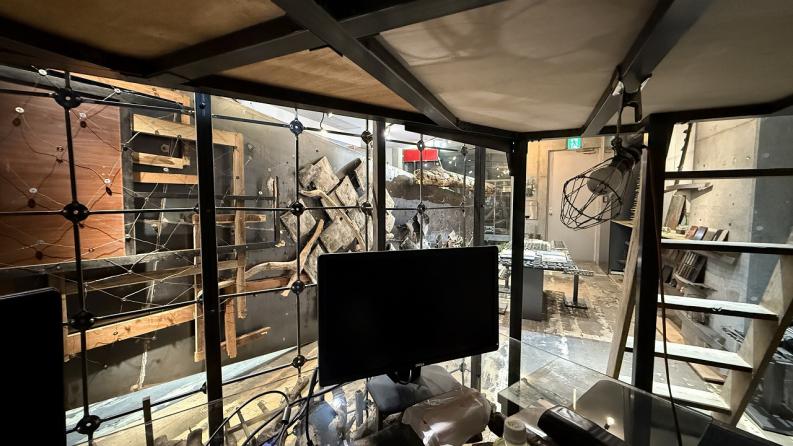
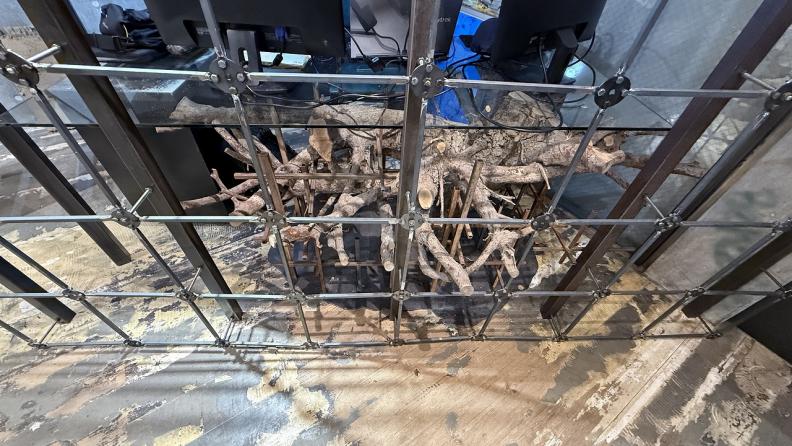
The upper floor is 1.5m high. You can’t stand upright under it, but once you sit down, you have more than 10cm of headroom, and you can work in a narrow but spacious space surrounded by floor, walls and ceiling. There is only one light illuminating the desk, and I think it’s easier to concentrate in a dark space.
This space is also physically “open on one side,” and is similar to an environment where light shines in from the exit of a cave. This is probably a common image that comes to mind when we imagine hope.
It is a space that allows for a high degree of independence and makes it easy to maintain high levels of concentration, and when you feel tired, just look up and you’ll be greeted by the view outside.
[Space above the loft: Climb a tree like a squirrel and look down]
Just like when a squirrel can’t find a chestnut, it climbs a tree and searches from a higher place. By raising your line of sight a little, you can see things that you can’t see from the ground. It can also help you develop a mischievous spirit. Just like the exciting things you did as a child.
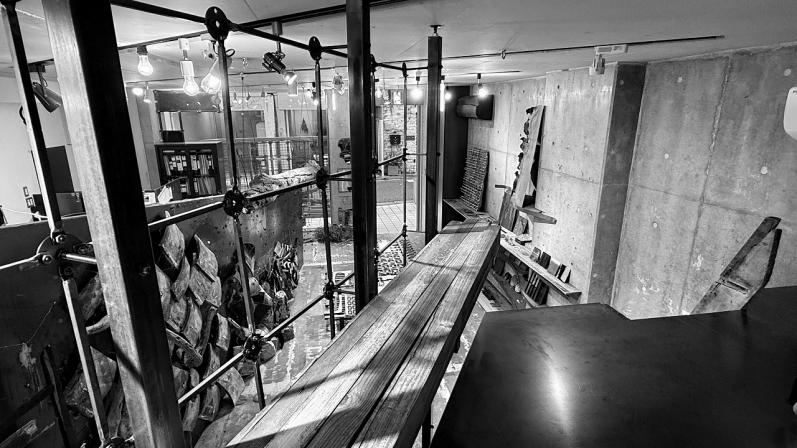

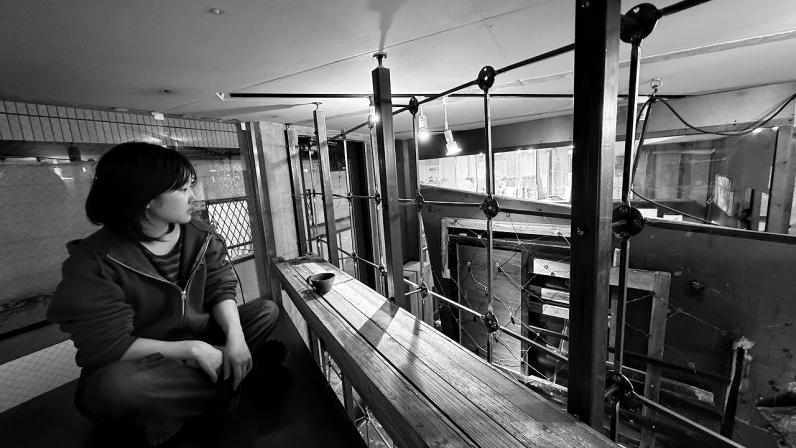

The loft is 1.5m high. Your line of sight rises to over 2.2m, changing the view. And the ceiling is 1m from the top of the loft. It’s high enough to sit down. We built a counter on one side of it. Three people can sit comfortably here. If you sit here side by side and chat leisurely over coffee, you can get to know the people around you.
In fact, I interviewed a client for the first time, side-by-side, and he said, “It’s very easy to talk to him.” Rather than talking face-to-face, each of us faces forward when we speak, which allows us to calm down and exchange words that come from our true selves.
In addition, the space other than the counter can be used for a variety of purposes, such as taking a nap, lying down to read a book, or as storage space.
[Wrapping up broken things]
From different angles above and below the loft, you can see that beyond the layers of the GRIDFRAME structure, broken objects are softly fixed in place by GF mesh, yet are exposed and form part of the wall surface.
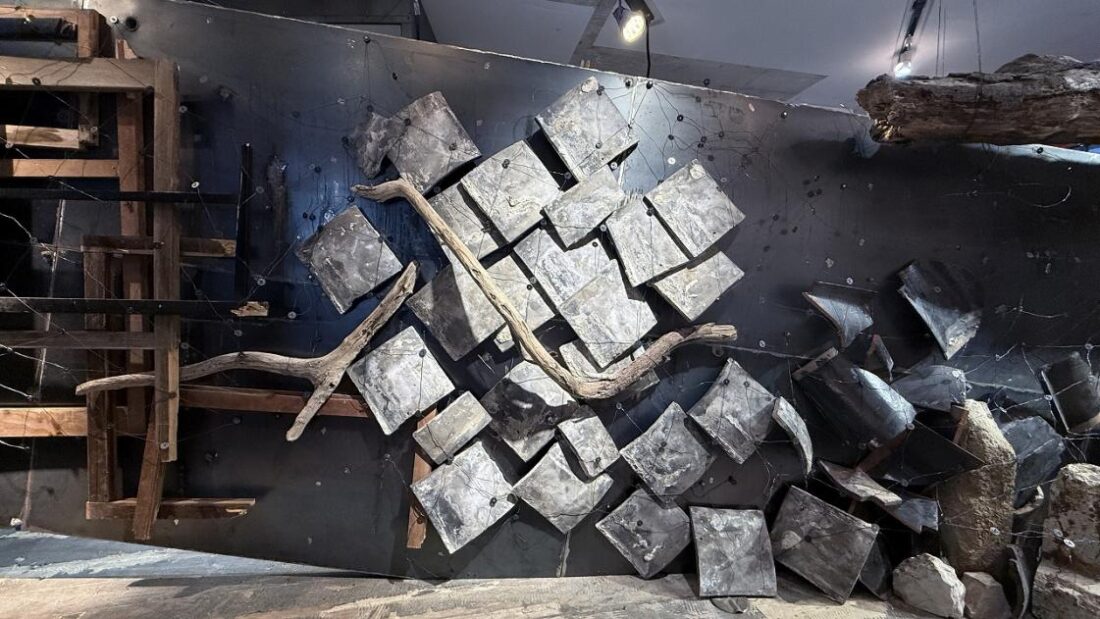
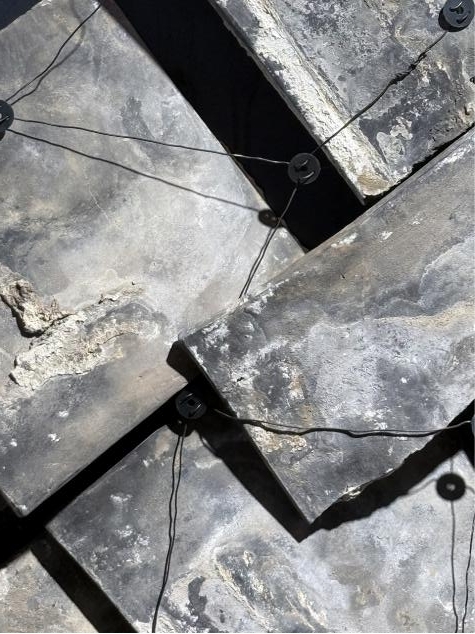
The further away the GF mesh is, the less noticeable it becomes, and it feels like you are looking at the broken object itself. In the part suspended by the GF mesh, the broken object appears to be floating.
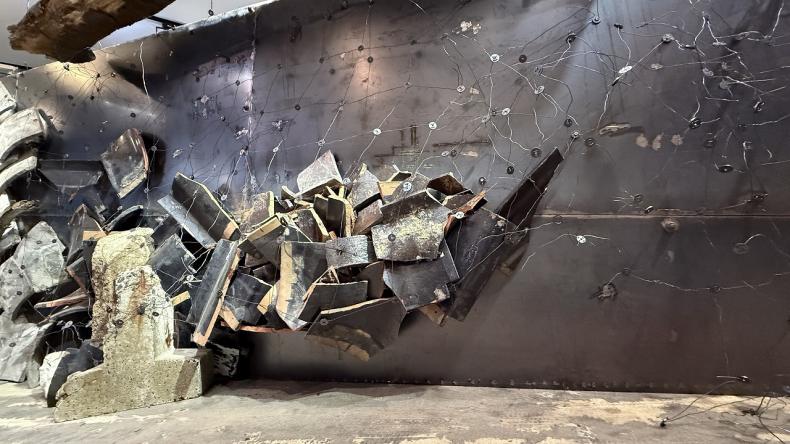
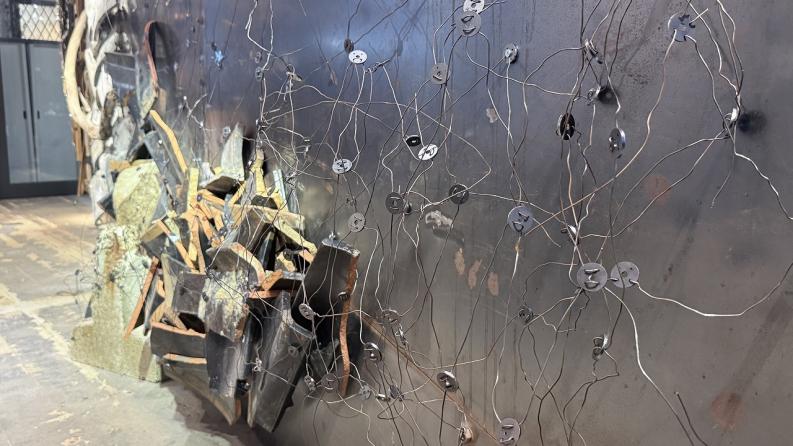
And when you get close to the broken object, you can feel the softness and gentleness of the GF mesh, wrapping around the broken object like fine capillary roots and supporting it.
For example, I think the impression you get of the GRIDFRAME structure at The Art of Tea TOKYO is completely different from the way it is firmly holding down broken objects.
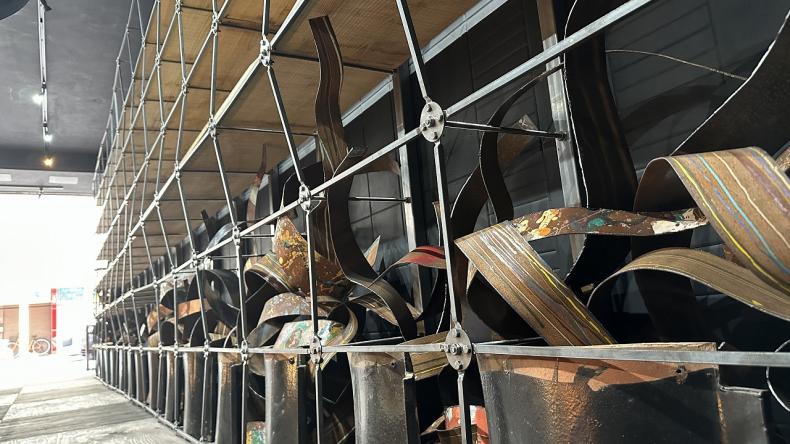
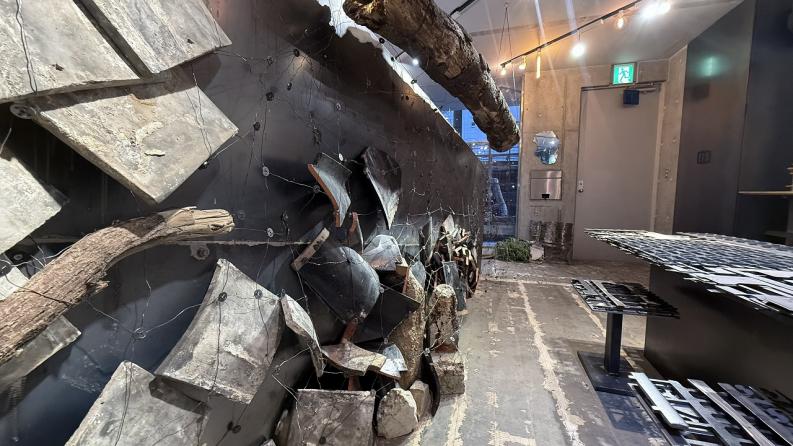
The GRIDFRAME structure is “filled”, whereas GF Mesh is “wrapped”.
Packing prioritizes the shape of the finished product and fits the broken item to that shape.
Wrapping prioritizes the shape of the broken item and fits the finished product to that shape.
GF Mesh was developed based on a suggestion from new staff member Suzawa. It is the result of our efforts to express through our manufacturing method the idea that broken things should not be called “rubble.”
As an aside, there are some people who sometimes say that the GF mesh joint parts are “cute” lol.
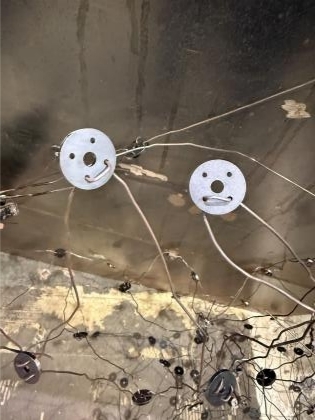
[Office space that encourages creativity]
We would like the spaces we create to provoke the question: what is it that reminds the person who is there that they are an irreplaceable existence?
In the business world, it is impossible to avoid seeing people as a means to an end, and therefore impossible to avoid feeling like you are irreplaceable. But it is you, the irreplaceable you, who opens up the future.
I think many people need a device that allows them to move freely between two worlds: the irreplaceable world and the irreplaceable world.
At Grid Frame, we have created a variety of spaces, not just offices, with the creation of such devices as our fundamental theme.
I think that a space that allows you to be creative also needs to be a relaxing environment. When we don’t want to think about anything, we want to be in an environment where we can blend in with many other people in a changeable world. This is because it is more relaxing. Such a space does not necessarily need to have a creative design. It can be ordinary at first glance.
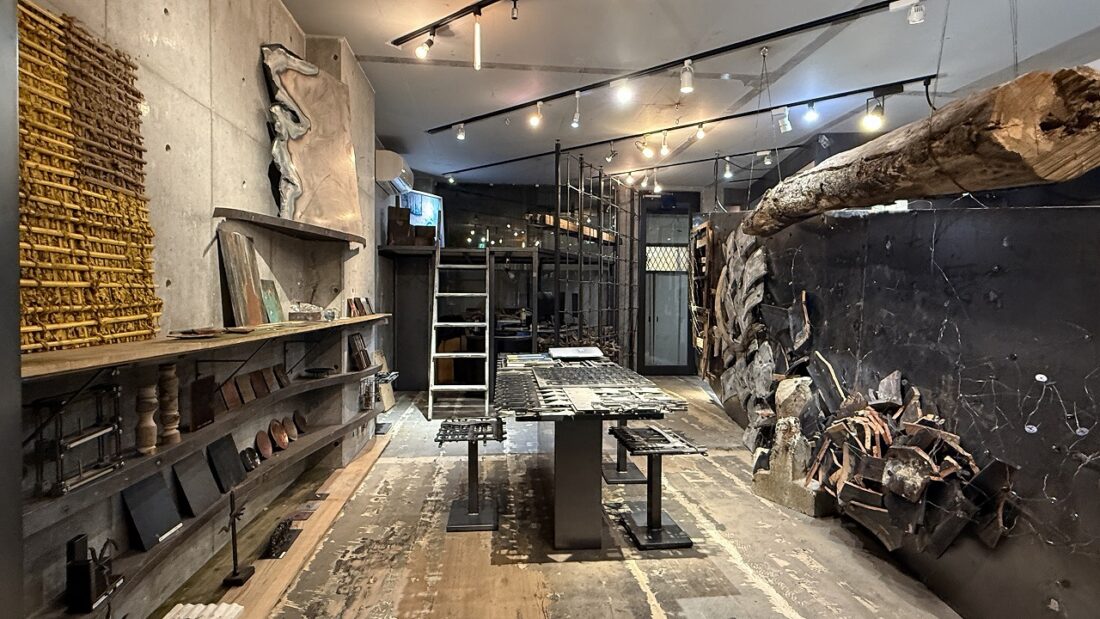
However, suppose there is something unfamiliar, mysterious and complex in the details of that space. If you stare blankly, it will not enter your consciousness, but if you focus, you will be drawn in and fascinated. SOTOCHIKU materials, starting with broken objects, have that power.
If you stare at it absentmindedly, it appears as a landscape, so the person there can remain in a world of irreplaceable things, but if you focus on it, a one-to-one relationship is formed and an irreplaceable world opens up. The person there can choose to belong to one of the two worlds.
This is the kind of space we mean by being able to move freely between two worlds, and we believe that an office for creative work is one of the spaces where this effect can be most clearly felt.
The showroom is the embodiment of this idea. First of all, I work in the showroom and realize what I have written so far. Please come to the showroom, sit at my desk under the loft, and sit at the counter above the loft and let’s have a relaxing chat over a cup of coffee.
<Project using scraps from factories>
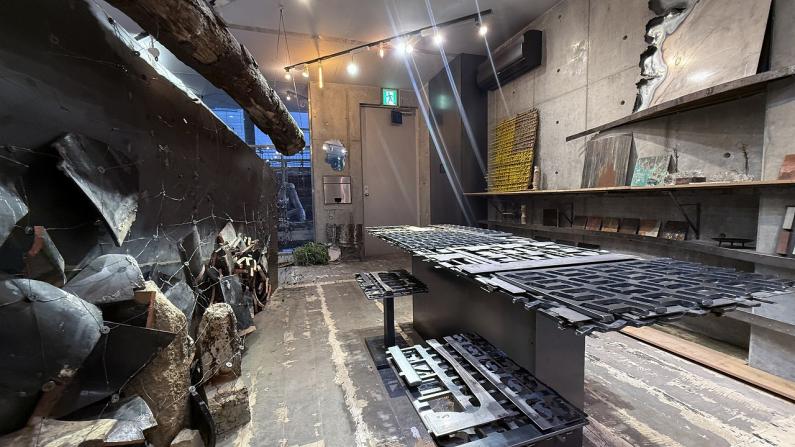
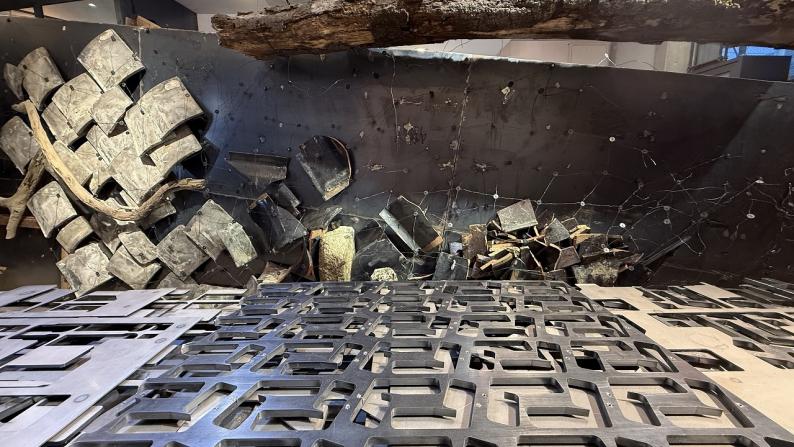
The showroom also displays products from a project that our partner Kubo is working on, which uses scrap materials from the factories of various companies that cooperate with GRIDFRAME’s manufacturing in Sumida Ward.
This was our first project, and we were provided with materials by a laser processing company. Metal plates that have been regularly cut into identical parts by a laser are usually melted down at recycling plants and regenerated as new metal plates. We purchased these before they were recycled and used them to make tables and chairs.
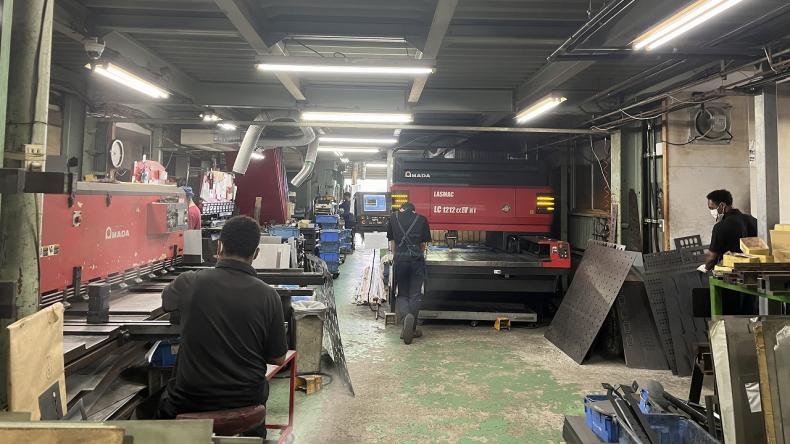
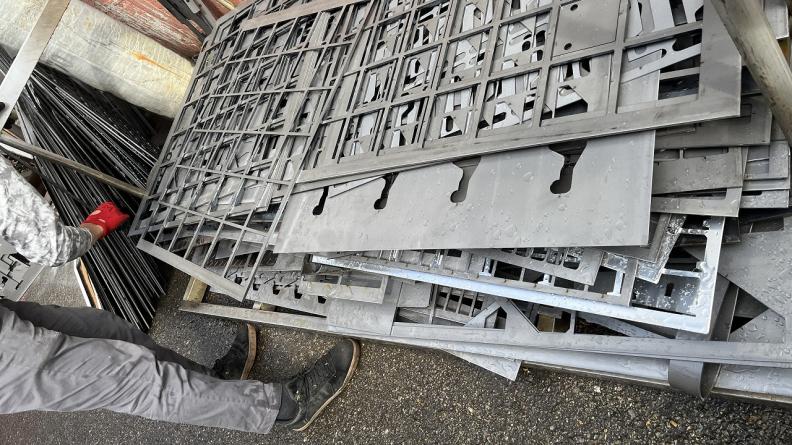
I think very few people think about the fact that our lives are supported by the people who work steadily in factories every day. When I look at the factory’s scraps, I feel like I can see the daily lives of the people who work in the factory as an afterimage. I want to create furniture that allows you to feel that in a simple way. That is the aim of this project.
Please come and see this in person as well.
In the next issue, we would like to tell you more about SOTOCHIKU’s various activities.
March 31, 2025 GRIDFRAME Toshiro Tanaka

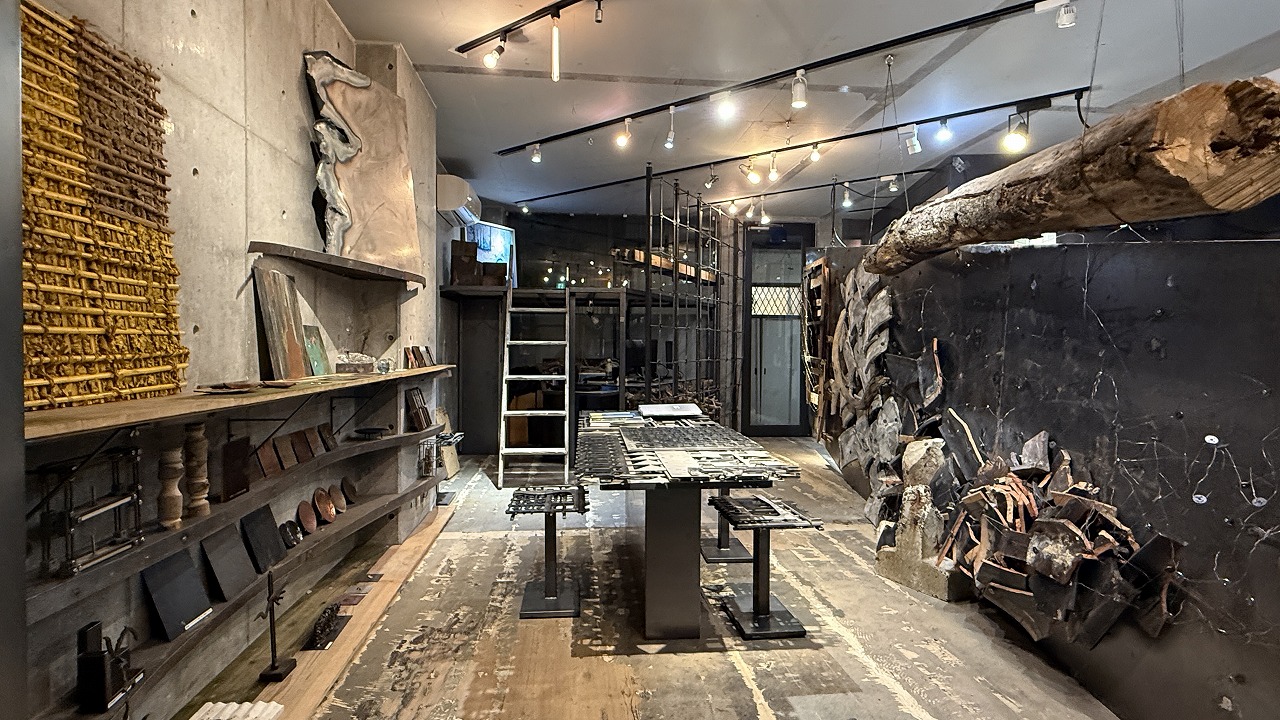
Comments are closed